To create a vanilla and bergamot essential oil perfume, you'll need to balance these complementary scents carefully. Start with a 1:3 vanilla to bergamot ratio, as vanilla can easily overpower the citrus notes. Use proper tools like glass beakers, droppers, and a digital scale for precise measurements. Store your blend in amber glass bottles away from light and heat, and apply to moisturized skin at pulse points. The perfect blend awaits as you explore the intricate art of perfume making.
The Magic of Vanilla and Bergamot Essential Oils
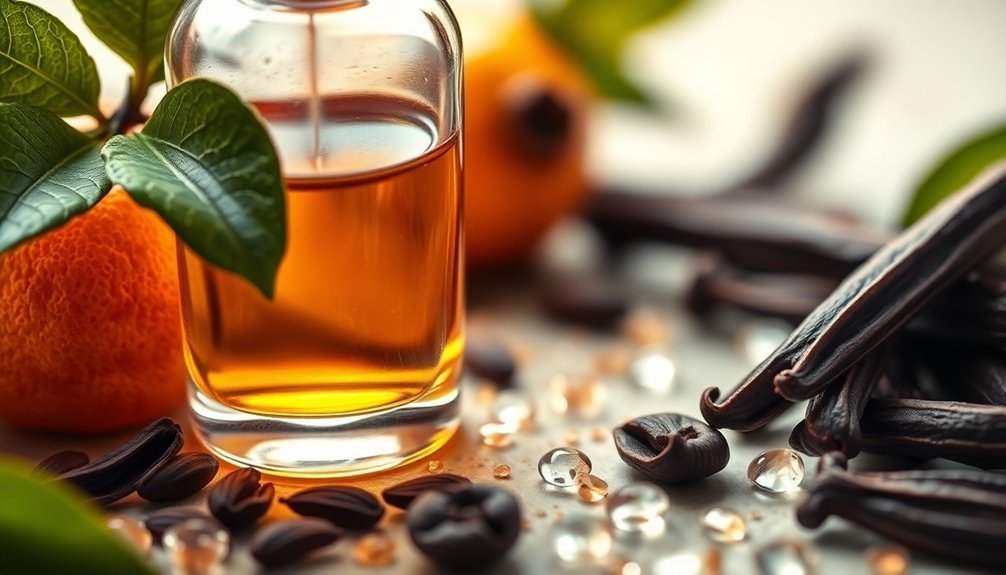
When it comes to creating enchanting essential oil perfumes, vanilla and bergamot stand out as a magical duo. You'll find vanilla's sweet warmth perfectly complementing bergamot's citrusy freshness, creating a balanced and distinctive fragrance that's both soothing and invigorating.
This powerful combination offers more than just a beautiful scent. While vanilla brings its natural antioxidant properties and aphrodisiac effects, bergamot contributes with its antiseptic qualities and mood-lifting benefits. The rich compounds found in vanilla oil promote testosterone production, making this blend particularly appealing for those seeking natural hormone support.
Whether you're looking to craft a signature scent or enhance your aromatherapy practice, this versatile blend delivers both therapeutic benefits and sensual appeal, making it an excellent choice for daily wear or creating a calming atmosphere.
Understanding Fragrance Notes and Blending Basics
You'll discover that fragrance notes fall into distinct categories, with top notes like bergamot creating initial impressions while base notes like vanilla provide lasting depth.
When blending essential oils, you're working with a dynamic interplay between sweet and citrus elements that can transform your perfume from one-dimensional to complex. Starting with a 20/30/50 ratio blend helps create a well-balanced perfume that highlights each note appropriately.
The key to successful blending lies in maintaining proper ratios between these contrasting notes, typically starting with lighter citrus oils and gradually building toward richer, sweeter base notes.
Top Vs Base Notes
Understanding the interplay between top and base notes is essential for creating balanced essential oil perfumes.
You'll notice that bergamot, as a top note, evaporates within 15 minutes, delivering an initial burst of fresh, citrusy aroma. Its lighter molecular structure makes it perfect for creating that first impression in your blend.
In contrast, vanilla's heavier molecular structure as a base note allows it to linger for six hours or more, providing depth and staying power to your perfume.
When you combine these notes, you're creating a dynamic fragrance that evolves over time. The bright, uplifting bergamot opens the scent while vanilla's warm, sweet characteristics emerge gradually, offering a long-lasting foundation that keeps your perfume grounded and interesting throughout its wear. This natural combination ensures your perfume remains free from harmful synthetic chemicals commonly found in conventional fragrances.
Balancing Sweet With Citrus
Building upon the relationship between top and base notes, the art of balancing sweet and citrus elements opens up a world of sophisticated fragrance creation. When you're working with citrus and sweet notes, you'll find bergamot is particularly versatile, offering both bitter and sweet characteristics that blend beautifully with vanilla.
You'll want to start by selecting your citrus elements – consider lemon, orange, or grapefruit for brightness.
Then, introduce sweetness gradually using vanilla or alternatives like raspberry ketone or peach lactone. These sweetening agents can soften harsh edges without overpowering the crisp citrus notes.
For the best results, follow the basic principle of combining contrasting scents harmoniously. Remember that citrus-sweet combinations work exceptionally well in spring and summer fragrances, making them perfect for warm-weather wear.
Essential Tools and Materials for Your Perfume Kit
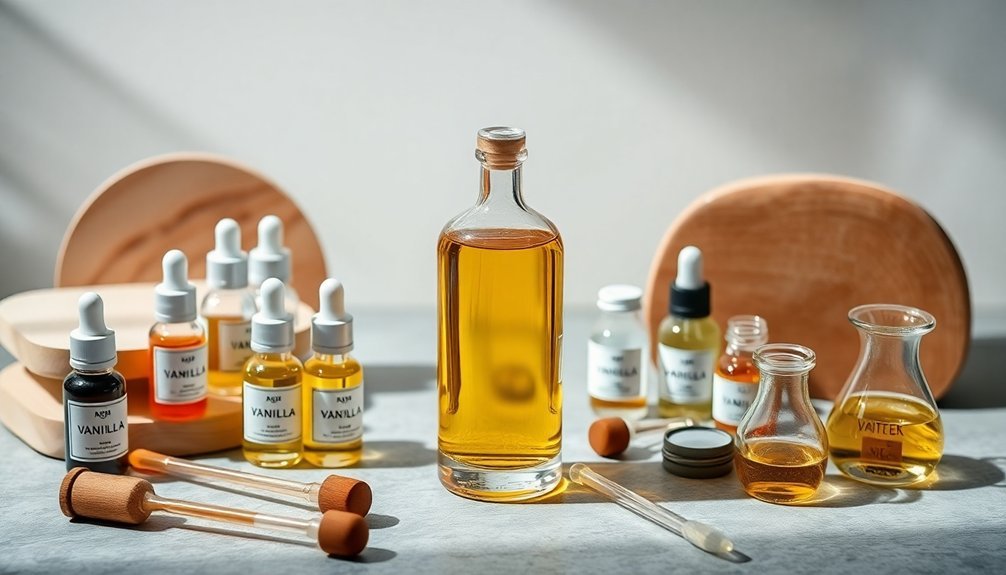
Before diving into essential oil perfumery, assembling the right set of tools and materials will guarantee both safety and success in your fragrance creation journey.
Proper preparation and the right tools form the foundation of safe, successful essential oil perfumery.
You'll need general equipment like fragrance blotters, digital scales, and glass beakers for testing and mixing your blends.
Don't overlook safety gear – protective gloves, safety glasses, and masks are vital when working with concentrated oils.
For precise measurements, you'll want measuring cylinders, droppers, and a magnetic stirrer with magnet bars to guarantee thorough blending.
Store your creations properly using glass bottles with plain caps and droppers.
Keep everything organized with adhesive labels, and always maintain a notebook to record your recipes and testing notes.
These tools aren't just accessories – they're essential components that'll help you create professional-quality perfumes safely and effectively.
Creating Your First Vanilla-Bergamot Base
While many perfumers start with complex blends, a vanilla-bergamot base offers an ideal entry point into essential oil perfumery. You'll find these two oils naturally complement each other, with bergamot's citrus brightness balancing vanilla's sweet warmth.
To create your base, start by adding 3-4 drops of bergamot essential oil to your blending vessel. As a top note, it'll provide immediate freshness to your blend.
Next, add 2-3 drops of vanilla oil to establish the sweet, lasting foundation. Test this combination on a fragrance strip and adjust the ratios until you achieve your desired balance.
For added depth, you can enhance your base by incorporating middle notes like lavender or rose geranium. These additions will bridge the gap between bergamot's initial burst and vanilla's lingering sweetness.
Mastering the Perfect Ratio: Measurements Guide

You'll want to start with 10 drops of vanilla essential oil as your base note in a small test batch, using a clean pipette for precise measurements.
Follow this by adding 5 drops of bergamot as your top note, keeping track of your ratios on paper to guarantee consistency when scaling up.
Once you're satisfied with your test blend's balance, you can multiply these measurements proportionally for larger batches, maintaining the 2:1 ratio of vanilla to bergamot.
Measuring Your Base Notes
Since base notes form the foundation of your perfume blend, mastering their measurements is essential for creating a lasting fragrance.
You'll want to allocate 5-25% of your composition to base notes, with common ratios suggesting 20-25% as an ideal range.
When working with potent base notes like vanilla, sandalwood, vetiver, or patchouli, start with smaller amounts to avoid overwhelming your blend.
You can follow the 30-50-20 ratio (20% base notes) or opt for the 25-45-30 ratio (25% base notes) as your starting point.
Remember, these aren't rigid rules – you'll need to adjust based on the strength of your oils and your desired outcome.
Test your blends on fragrance strips to fine-tune the proportions until you achieve the perfect balance of depth and longevity.
Starting With Test Drops
After establishing your base note measurements, the next step involves testing your blend with precise drop counts.
Start by placing a single drop of Vanilla and Bergamot on separate test strips to evaluate their individual characteristics. You'll notice Vanilla's rich, deep base notes and Bergamot's bright, citrusy top notes.
Begin experimenting with different ratios, keeping in mind the standard 3:5:2 proportion for top, middle, and base notes. However, don't feel confined by this rule – you'll need to adjust based on each oil's strength.
Place your test drops on a perfume strip, swirl them together, and assess how they interact. Pay attention to how the scent develops over time, and make notes of which combinations create the most appealing balance for your desired fragrance profile.
Scale For Large Batches
Scaling up essential oil perfume formulas requires a shift from drop measurements to weight-based calculations using specific gravity.
You'll need an electronic scale to guarantee precise measurements, as drops can vary considerably in volume and weight.
To scale up your blend, first convert your original formula to percentages by multiplying each oil's drop count by its specific gravity to get the weight.
Then, divide each oil's weight by the total weight to determine its percentage. You can now use these percentages to create larger batches while maintaining the traditional 3:5:2 ratio of top, middle, and base notes.
Remember to follow IFRA safety guidelines, which are expressed in percentages, and keep your essential oil concentration around 20% in non-alcoholic blends.
Using spreadsheets will help you track and adjust your formulas accurately.
Adding Complementary Scents to Your Blend
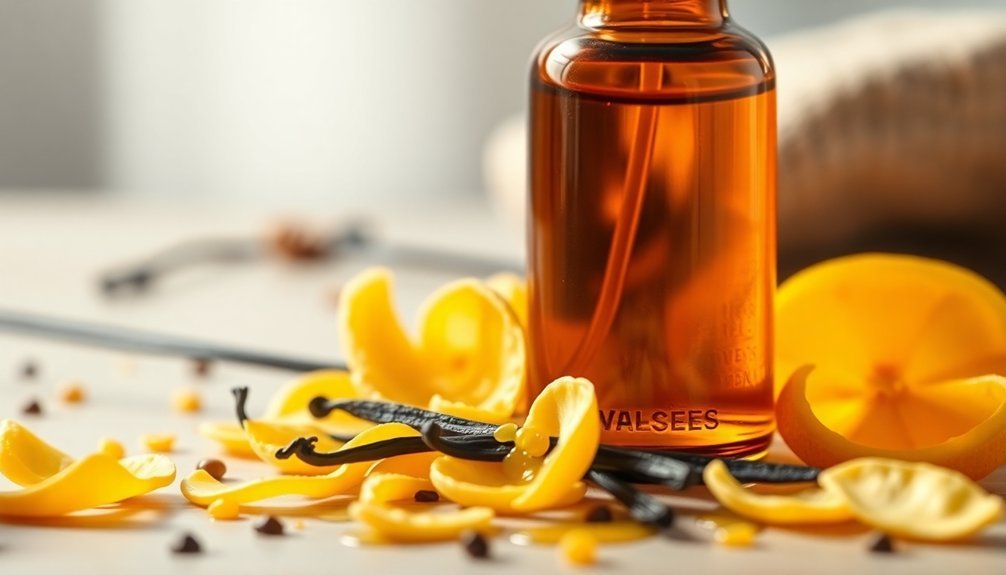
When creating your essential oil perfume, understanding how to layer complementary scents is crucial for achieving a balanced and sophisticated blend.
Start by adding floral notes like lavender or ylang ylang to enhance your vanilla and bergamot base.
You'll find that woody elements such as cedarwood or sandalwood can provide depth and warmth, while spicy notes like black pepper or cinnamon leaf introduce an intriguing complexity to your creation.
- Pair bergamot with floral scents to create a bright, feminine fragrance
- Add woody notes to ground your blend and create lasting power
- Include spicy elements to add dimension and intrigue
- Consider herbal additions like chamomile or basil for a fresh, natural touch
Use the scent wheel as your guide, and don't be afraid to experiment with both neighboring and contrasting fragrance families.
Storage and Shelf Life of Your Custom Perfume
Once you've crafted your perfect essential oil blend, proper storage can make the difference between a lasting signature scent and a spoiled mixture.
Store your custom perfume in an upright position, away from direct light and heat sources, ideally in a cool, dark place around 60°F.
Your blend's shelf life depends largely on its ingredients and storage conditions. Citrus-based scents like bergamot tend to expire more quickly than deeper fragrances.
Keep your creation in its original amber or glass bottle, ensuring it's tightly sealed when not in use to minimize oxygen exposure.
If you're traveling with your perfume, use a travel-sized atomizer to prevent spills.
Always check for signs of spoilage, such as discoloration or changes in consistency, before applying. A mini beauty fridge can provide ideal storage for your precious blend.
Therapeutic Benefits of Your Signature Scent
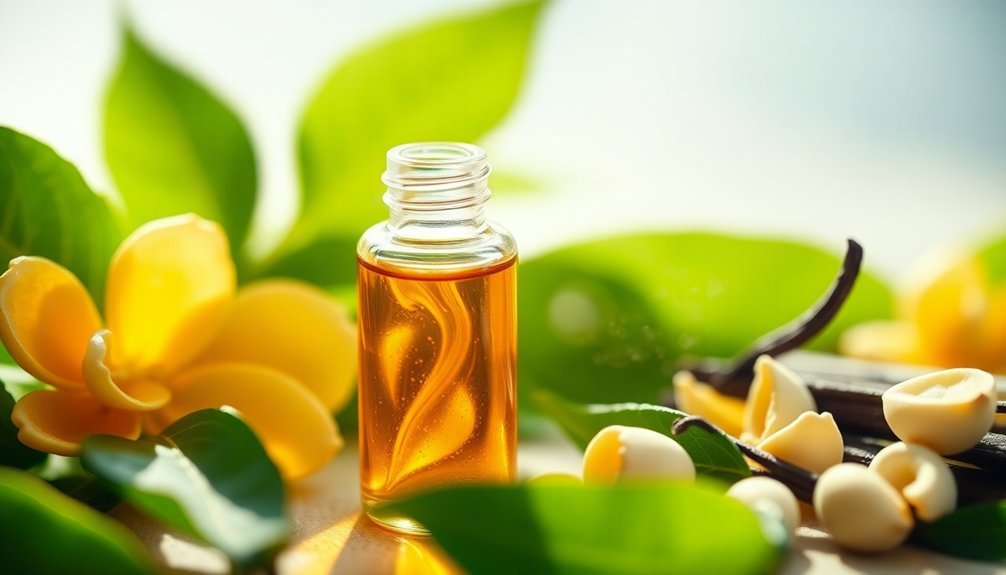
Your custom essential oil perfume can serve as a powerful tool for balancing mind and body, especially when combining therapeutic ingredients like vanilla and bergamot.
The natural compounds in these essential oils work directly with your brain's limbic system to enhance mood, reduce stress, and promote overall well-being.
Mind-Body Balance Benefits
Creating a signature scent goes far beyond simply smelling good – it's a powerful tool for achieving mind-body balance through aromatherapy. When you blend vanilla and bergamot with complementary oils, you're crafting a personalized therapeutic experience that can enhance your physical and emotional wellbeing.
These carefully chosen scents work synergistically to reduce stress, improve focus, and promote emotional stability throughout your day.
- Combine vanilla's soothing properties with bergamot's uplifting effects to create a balanced emotional state
- Add woody oils like cedarwood for grounding and enhanced mind-body connection
- Include citrus notes to boost energy and mental clarity when needed
- Layer in floral elements for stress reduction and deeper relaxation
Integrate your signature blend into meditation, breathing exercises, or yoga practice to maximize its therapeutic benefits.
Natural Mood Enhancement Power
While many people seek synthetic fragrances for their daily wear, natural essential oils offer powerful mood-enhancing properties that can transform your emotional well-being.
When you combine vanilla and bergamot, you'll create a balanced blend that targets both relaxation and upliftment. Vanilla's warming properties promote calmness and emotional stability, while bergamot's citrusy notes act as a natural antidepressant, reducing anxiety and stress.
You can customize your blend by starting with either vanilla or bergamot as your dominant note, then adjusting the proportions to suit your needs.
This versatile combination works effectively in a diffuser or as a perfume oil, offering you the flexibility to enhance your mood throughout the day. The synergistic effects of these oils provide deeper benefits than using them individually.
Season-Specific Vanilla-Bergamot Variations
The art of blending vanilla and bergamot takes on distinctive characteristics throughout the year as seasonal elements influence our perfume preferences.
You'll discover how each season calls for unique modifications to this versatile base.
Spring awakens with floral notes like rose geranium, while summer embraces citrus additions of lemon and lime.
As autumn arrives, you can incorporate warm spices such as cinnamon, and winter welcomes the crisp touch of balsam fir.
- Spring's blend uplifts with fresh florals and a light vanilla touch
- Summer's variation refreshes with bright citrus and cooling elements
- Autumn's mix comforts with warm spices and grounding notes
- Winter's formula enchants with evergreen touches and rich vanilla depth
These seasonal adaptations guarantee your perfume perfectly matches both the weather and your mood throughout the year.
Troubleshooting Common Blending Challenges

Successful essential oil blending requires maneuvering common challenges that even experienced perfumers face. When working with vanilla and bergamot, you'll need to monitor your blend's balance carefully, as vanilla can easily overpower bergamot's delicate citrus notes. Test your blends over time to guarantee the aroma remains stable and pleasant.
| Challenge | Cause | Solution |
|---|---|---|
| Dominant Vanilla | Incorrect ratio | Start with 1:3 vanilla to bergamot |
| Fading Citrus | High evaporation rate | Add citrus fixative or stabilizer |
| Flat Aroma | Limited note variety | Layer complementary middle notes |
To achieve complex, well-balanced blends, you'll want to conduct organoleptic testing at different stages and document your ratios. Consider using trial blends at varying concentrations (3:2:1) to find your ideal combination, always staying within safe dilution guidelines.
Scaling Your Recipe for Different Applications
Creating larger batches of essential oil perfumes requires precise calculations and careful attention to proportions.
When scaling up your Vanilla and Bergamot blend, you'll need to take into account the specific gravity of each oil to maintain consistency.
Remember that roll-on perfumes need carrier oil dilution, while room sprays and other applications may require different base ingredients.
- Calculate the specific gravity of each essential oil to convert drops into precise weights
- Maintain your original ratio of top notes (10-30%) when increasing batch size
- Adjust base ingredients according to your final product (perfume, candle, or spray)
- Think about adding more base notes like Vanilla for enhanced stability in larger batches
Your scaled recipe will still need proper maturation time, allowing the oils to blend harmoniously regardless of batch size.
Professional Tips for Long-Lasting Fragrance
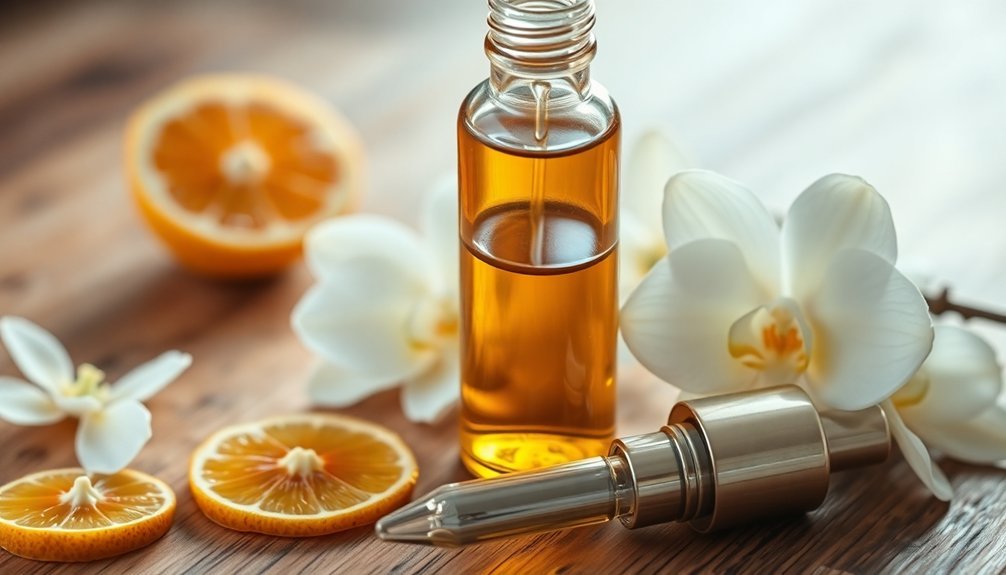
While mastering essential oil perfumery requires practice, achieving long-lasting fragrances boils down to strategic formulation and proper application techniques. You'll want to focus on both the blend composition and application methods to maximize your perfume's staying power.
| Element | Strategy |
|---|---|
| Base Notes | Use vanilla absolute or sandalwood at 25% concentration |
| Fixatives | Add benzoin or myrrh to anchor the scent |
| Carriers | Choose high-proof alcohol over carrier oils |
| Application | Apply to moisturized skin and pulse points |
To enhance your blend's longevity, start with a strong foundation of base notes, then layer in your middle notes like rose geranium or lavender. Top off with bergamot, using it sparingly to maintain balance. Don't forget to let your blend mature for at least 24 hours before testing its staying power.
Frequently Asked Questions
Can I Use Vanilla Extract Instead of Vanilla Essential Oil?
No, you shouldn't use vanilla extract as a substitute for vanilla essential oil. It's mainly for cooking, contains alcohol that can irritate skin, and won't provide the lasting fragrance you need in perfumes.
Will Bergamot Essential Oil Stain My Clothes When Used as Perfume?
You're unlikely to get stains from Bergamot essential oil as it's light-colored and volatile. However, you should still dilute it with a carrier oil and let it dry before putting on clothes.
Is This Blend Safe to Use During Pregnancy?
You shouldn't use this blend during pregnancy, especially in the first trimester. Both oils need extra caution while pregnant. It's best to consult your healthcare provider before using any essential oils.
Can I Wear This Perfume Blend to the Beach or Pool?
You shouldn't wear this perfume to the beach or pool. It can interact with sunscreen and pool chemicals, fade quickly in heat, and potentially cause skin sensitivity when exposed to sun.
Does the Vanilla-Bergamot Blend Attract or Repel Insects When Worn Outdoors?
You'll get mixed effects: bergamot may slightly repel insects, while vanilla won't. For outdoor protection, you should use proven insect repellents instead, as this blend isn't reliable for keeping bugs away.

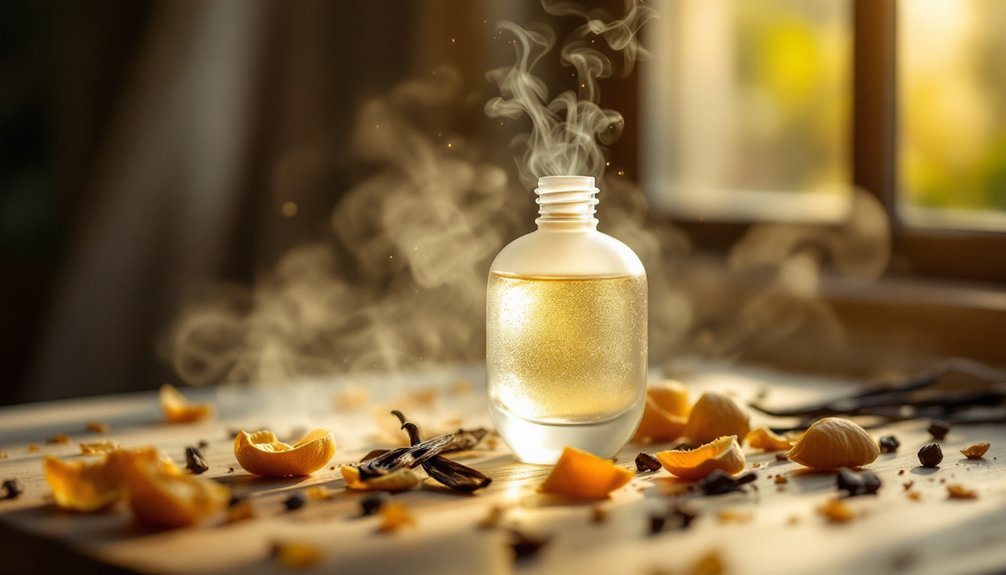



Leave a Reply